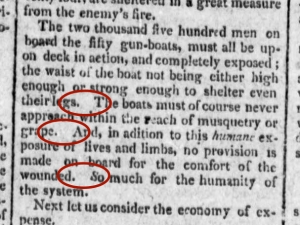When I was learning to type, I was taught to use two spaces after end punctuation. Later on, I learned that using two spaces was really essential when typing on typewriters, but it’s no longer necessary when typing on a computer. Is it actually incorrect now to use two spaces, or should people just do whichever they’re more comfortable with?
–Stephanie
This remains hotly debated in some circles, and I was going to say that seems a bit silly to me until I remembered how excited many editors get over the serial comma question, and then I decided to keep my mouth shut.
The story that everyone gets told at some point is that the double-spacing thing was created with the typewriter because typewriters use monospace fonts—that is, every character is allotted the same amount of space (a period takes up the same width as an M, for example). This led to a lot of white space on the page, as skinny characters were centered in a space as wide as thicker characters (and often given huge serifs to compensate). The theory was that by adding an extra space after end punctuation, it would more clearly delineate the end of a sentence.
 But it turns out that’s just not true. The short version is, typesetters had been putting large spaces after end punctuation for centuries. The long version is… well, just check out this exhaustive blog post by someone who’s done way more research on this topic than I mean to do. But if you don’t believe me, you can verify this yourself by poking around in the Library of Congress site or on Google image search. The photo at right shows a clip from a newspaper dated 1807, several decades before the typewriter become commercially available, and you can see that the font is proportional, but there’s still big ol’ spaces after the periods. (You can also see spaces on either side of the semicolon at the end of the third line, which is another thing typesetters used to do.)
But it turns out that’s just not true. The short version is, typesetters had been putting large spaces after end punctuation for centuries. The long version is… well, just check out this exhaustive blog post by someone who’s done way more research on this topic than I mean to do. But if you don’t believe me, you can verify this yourself by poking around in the Library of Congress site or on Google image search. The photo at right shows a clip from a newspaper dated 1807, several decades before the typewriter become commercially available, and you can see that the font is proportional, but there’s still big ol’ spaces after the periods. (You can also see spaces on either side of the semicolon at the end of the third line, which is another thing typesetters used to do.)
So two or way-more-than-two spaces was the standard for hundreds of years, until the middle of the 1900s, when typists and style guides started moving toward the one-space standard. This is the same time that electric typewriters with proportional fonts became popular, so whether they directly caused the change or not, you can see how people would think that the death of the monotype font and the two-space standard were inextricably linked.
The blogger I linked above gives three theories for why people moved to the one-space standard, all of which sound plausible to me:
- It’s cheaper. Text takes up less space, saving paper and therefore money.
- It required less expertise for typesetters, who no longer had to find each punctuation mark and figure out if it was the end of a sentence or not.
- Increased automation meant that two spaces in a row could get split up over two lines, starting the second line with a blank space, which looks bad.
But regardless of the reason for the switch, nearly all typographers and style guides have agreed on one space for the past 50 years. It is fundamentally an arbitrary standard, but that doesn’t mean people should just use whatever they want. Fashion is fundamentally an arbitrary standard, but if you show up to work tomorrow in go-go boots or giant bell-bottoms, you’re going to seem pretty out of touch. Which is exactly how you seem if you use two spaces after a period.
If “times have changed” isn’t reason enough for you to go with one space, consider this: Many layout programs ignore multiple spaces and reduce them to one. HTML does the same. And if you’re writing for publication, the first thing your editor is going to do is search and replace any instances of two spaces with one. So you’re hitting the space bar hundreds of extra times for absolutely no reason. It’s just wasted effort.
If you grew up using two spaces and can’t seem to break the habit, you’re not hurting anything if you continue doing it. It’s not “wrong” any more than ’80s hair is “wrong,” it just looks pretty silly in 2012. But I do encourage you to drop the extra space if you can manage it. That look went out with the bullet bra.
I was taught to use two spaces when I took a typing class in eighth grade. It took me maybe a week or two to break the habit when the semester ended. I’ve never understood the fervor with which some people cling to their two spaces.
You also need to consider the audience. In certain U.S. military reports and documents (at least in the Navy) you are still to this day required to double space after periods (at the end of a sentence) and semi-colons. This is just the style they’ve held onto.